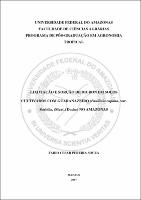| ???jsp.display-item.social.title??? |


|
Please use this identifier to cite or link to this item:
https://tede.ufam.edu.br/handle/tede/5865| ???metadata.dc.type???: | Dissertação |
| Title: | Lixiviação e sorção de diuron em solos cultivados com guaranazeiro (Paullinia cupana, var. Sorbilis (Mart.) Ducke) no Amazonas |
| ???metadata.dc.creator???: | Souza, Fabio Cesar Pereira  |
| ???metadata.dc.contributor.advisor1???: | Albertino, Sônia Maria Figueiredo |
| First advisor-co: | Silva, José Ferreira da |
| ???metadata.dc.description.resumo???: | As plantas daninhas na cultura do guaranazeiro influenciam diretamente na competição por água, luz e nutrientes e indiretamente, como hospedeiras de pragas e doenças, podendo assim trazer prejuízos aos cultivos. Portanto, o conhecimento sobre a eficiência do controle químico de plantas daninhas, pode ser estudado por meio dos processos de lixiviação e sorção do herbicida no solo. O objetivo desse trabalho foi avaliar o potencial de lixiviação do herbicida diuron em solos cultivados com guaranazeiro, coletados nos municípios de Maués-AM e Itacoatiara-AM. Este estudo foi conduzido em casa de vegetação e para avaliar o potencial de lixiviação, foram utilizadas colunas de tubo de PVC medindo 42 cm de comprimento, com 10 cm de diâmetro, onde foram acondicionadas as amostras de solo, conforme a profundidade de coleta no campo (0-10, 10-20, 20-30, 30-40 cm). No topo das colunas foram aplicadas cinco doses de diuron (0, 200, 400, 800, 1600 g de i.a. ha-1) e feita simulação de chuva de 100 mm. Como planta bioindicadora foi utilizado o pepino (Cucumis sativus var. Aodai). O delineamento experimental adotado foi o inteiramente casualizado, em esquema fatorial 2 x 5 x 4, sendo dois locais de coleta, cinco doses de diuron e quatro profundidades do solo), com quatro repetições. Em estudo paralelo foi feita a avaliação da sorção do diuron em substrato inerte (areia), utilizando recipiente plástico de 550 mL contendo 3 sementes de pepino, onde foram aplicadas nove doses de diuron (0, 3, 6, 9, 12, 15, 18, 21, 24 g de i.a. ha-1), com cinco repetições. As características avaliadas foram área foliar (cm2) e peso seco da parte aérea (g). As plantas bioindicadoras foram coletadas aos 14 dias após a semeadura (DAS). Para o solo de textura muito-argilosa e argilosa o herbicida diuron ficou retido na primeira camada de 0-10 cm, mais especificamente até 5 cm de profundidade, onde foi observado fitotoxicidade das plantas bioindicadoras. O I50 do diuron para o solo, foi de 620 g de i.a. ha-1. A matéria orgânica e o teor de argila foram os fatores que mais influenciaram na retenção do herbicida nos solos estudados. |
| Abstract: | The weeds in the guarana crop directly influence the competition for water, light and nutrients and indirectly, serving as a host of microorganisms, and can thus damage the crop. Therefore, the study of herbicide leaching and sorption processes in the soil helps in the knowledge about the efficiency of weed control. The objective of this work was to evaluate the leaching potential of the herbicide diuron in soils cultivated with guaraná, collected in Maués-AM and Itacoatiara-AM municipalities. This study was carried out under greenhouse conditions and to evaluate the leaching potential, the soil columns were mounted in a PVC pipe 42 cm long and 10 cm in diameter, where the soil samples were conditioned according to each depth, using four depths (0-10, 10-20, 20-30, 30-40 cm). At the top of the columns were applied five doses (0, 200, 400, 800, 1600 g ha-1 i.a.) and made 100 mm rain simulation. Cucumis (Cucumis sativus) var. Aodai was used as a bioindicator. In this experiment, a completely randomized design (DIC) was used in a factorial scheme (2 x 5 x 4) representing (soil location x dose x depth) with four replications. In a parallel study, it was evaluated the sorption of diuron using inert substrate (inert sand), using a 550 ml plastic container containing 3 cucumber seeds, where it was applied nine doses (0, 3, 6, 9, 12, 15, 18 , 21, 24 g ha-1 i.a.) and five replicates using DIC. The evaluated characteristics were leaf area (cm2) and dry weight of the aerial part (g), the values were transformed into a percentage, adopting 100% for the control, where the bioindicator plants were collected at 14 DAS (Days After Sowing). For the soil with a very clayey and sandy clay texture, the herbicide diuron was retained in the first layer of 0-10 cm, more specifically up to 5 cm deep, where it was possible to observe phytotoxicity of bioindicating plants. The I50 of diuron to the soil was 620 g ha-1 i.a. The organic matter and clay content were the factors that most influenced the retention of the herbicide in the studied soils. |
| Keywords: | Plantas daninhas Matéria orgânica Resíduo orgânico |
| ???metadata.dc.subject.cnpq???: | CIÊNCIAS AGRÁRIAS: AGRONOMIA |
| Language: | por |
| ???metadata.dc.publisher.country???: | Brasil |
| Publisher: | Universidade Federal do Amazonas |
| ???metadata.dc.publisher.initials???: | UFAM |
| ???metadata.dc.publisher.department???: | Faculdade de Ciências Agrárias |
| ???metadata.dc.publisher.program???: | Programa de Pós-graduação em Agronomia Tropical |
| Citation: | SOUZA, Fábio Cesar Pereira. Lixiviação e sorção de diuron em solos cultivados com guaranazeiro (Paullinia cupana, var. Sorbilis (Mart.) Ducke) no Amazonas. 2017. 35 f. Dissertação (Mestrado em Agronomia Tropical) - Universidade Federal do Amazonas, Manaus, 2017. |
| ???metadata.dc.rights???: | Acesso Aberto |
| ???metadata.dc.rights.uri???: | http://creativecommons.org/licenses/by-nc-nd/4.0/ |
| URI: | http://tede.ufam.edu.br/handle/tede/5865 |
| Issue Date: | 26-May-2017 |
| Appears in Collections: | Mestrado em Agronomia Tropical |
Files in This Item:
| File | Description | Size | Format | |
|---|---|---|---|---|
| Dissertação - Fabio C. P. Souza.pdf | 903.2 kB | Adobe PDF |  Download/Open Preview |
This item is licensed under a Creative Commons License





